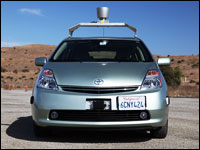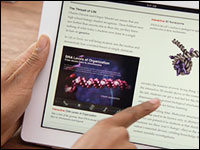
U.S. broadband providers have gotten away with shoddy speeds and restricted access because Americans consumers are pretty clueless about what they’re actually buying. A whopping 80 percent of broadband users in the United States do not know the speed of their own broadband connection, a Federal Communications Commission (FCC) survey found. It’s no surprise, then, that the nation is stupidly happy with the suckiest broadband speeds on the planet. Even many third-worlders are rocking rich media faster than the richest American household.
“While Europe and Japan have Fiber to the X (FTTX) services, we have not rolled out much here in the U.S. at this time,” Asif Hazarika, senior director of product management at IP Infusion, told TechNewsWorld. “The issue that we see is that the U.S. has a great deal of legacy deployment and thus, to match the speeds with GPON or EPON, the cost is much higher.”
Mobile broadband, says FCC Chairman Julius Genachowski, is a quick fix to this dilemma — but the U.S. is dead-weight, if not dead-last, in mobile broadband too.
“The U.S. is definitely behind the rest of the world in mobile broadband access, both from pricing and access speeds,” explained Hazarika.
Genachowski insists that 4G mobile broadband is the best way to “drive innovation, to drive broadband’s success, and to drive competition in broadband” prices and accessibility. But is mobile broadband a true fix or just a patch for the American “best country in the world” psyche?
Raw Rubs
Typically, Americans look at broadband speeds only long enough to select a monthly payment amount they will be paying to a provider year after year. Often, the monthly fee is significantly higher than fees for faster broadband speeds in other countries. American wallets are then further plundered by variations in the speed they purchased. Some are due to legitimate impediments to the technology; others are more a matter of profit enhancements. In any case, Americans rarely receive the broadband speeds they pay for.
“Due to average revenue per user and profitability issues in the last few years seen by the carriers, they have not spent a lot of capital expenditure to upgrade their networks,” noted Hazarika.
To combat this problem, the FCC is planning on measuring actual broadband speeds delivered to consumers and comparing them to the speeds that broadband providers advertise.
“Speed matters,” said FCC Chairman Julius Genachowski. “The more broadband subscribers know about what speeds they need and what speeds they get, the more they can make the market work and push faster speeds over broadband networks.”
There is more than potential false advertising and consumer fraud at issue here. The U.S. cannot compete for jobs without a strong broadband infrastructure. This makes the poor broadband performance in this country more than sucky — it makes it a huge economic drain.
The U.S. places 17th in a ranking of 154 countries commissioned by the United Nations, “Measuring the Information Society — the ICT Development Index.” The report attributes the U.S.’ continuing plummet to stagnation. By comparison, other countries have continued to improve speeds, access and related technologies. Sweden, South Korea, Denmark, the Netherlands and Iceland were the top five in overall ranking.
Consumer Force in the Free Market
“There is not much competition in any area for the same technology, and at this time, they are not being forced to improve,” said Hazarika. “If the FCC opens up the field for other providers competing in the same area, that may force the traditional LEC or MSO to improve.”
The FCC’s overall broadband speed initiative involves several bureaus and offices and is being coordinated by the Commission’s Consumer Task Force. Included in that effort are two new measurement programs.
In the first, the FCC is asking for 10,000 volunteers to participate in a scientific study to measure home broadband speed in the U.S. Participants will be required to install specialized hardware that, by the study’s end, will measure the performance of all the country’s major Internet service providers across geographic regions and service tiers. Anyone can register as a volunteer for this national test at www.TestMyISP.com. The findings will be published in an FCC “State of Broadband” report to be released later this year.
In the second program, the FCC is attempting to measure mobile broadband speeds by eliciting suggestions from the public and by providing a series of tests consumers can run themselves on their mobile phones and home networks. The first of these consumer tests is available here.
“Today, most people just know that their home broadband speed is supposed to be ‘blazing fast,'” said Joel Gurin, chief of the Consumer and Governmental Affairs Bureau of the FCC.
“They need more meaningful information to know exactly what speed they need for the applications they want to run, and what provider and plan is their best choice,” he said. “The difference between an inexpensive low-speed plan and an expensive, high-speed plan can be hundreds of dollars a year. Consumers need to be able to choose wisely.”
A Government Quandary
Broadband is commonly seen as the fourth utility, meaning it is as important to economic development as the other three: electricity, water and telephone services. As such, the federal government is unwilling to leave its development to profit-driven chance. Its efforts to drive broadband in the U.S. forward are hailed by some and vilified by others.
“The U.S. is on the path to become very competitive in the race to deploy broadband services as evidenced by the US$7.2 billion Broadband Stimulus initiative, the implementation of the FCC’s National Broadband Plan, the restructuring of the $7.7 billion per year Universal Services Fund to subsidize broadband build-out through a new Connect America initiative, and the FCC’s plan to establish a mobile broadband plan,” Gary Bolton, vice president of Global Marketing at ADTRAN told TechNewsWorld.
“Federal subsidies, along with private investment, will allow the U.S. to have high-bandwidth competitive broadband services available across the nation,” he added.
In essence, the FCC is treating broadband as a category unto itself and is, at least for the purpose of stimulus money, not excluding any delivery method.
“The FCC is roping mobile into the broader broadband plan,” Mike Jude, program manager of Consumer Communications Services at Frost & Sullivan, told TechNewsWorld.
“That could be good or bad news,” said Jude. “The good news is that it qualifies mobile broadband for stimulus money and other incentives, including favorable status for cell tower placement.”
The bad news, he continued, is that the feds are moving to regulate broadband “in ways unlike anything that has gone before.” Many of the rules and regulations to come are yet to be determined.
“These changes provide some virtues but they come with a fair amount of baggage,” explained Jude. “The verdict is still out on both — on how well the stimulus package weighs against the burdens of regulation.”
Leaving broadband’s future to free market will is not an option, though — if it were, the richest nation in the world would have the best broadband speeds imaginable.





















































